What's New in Wild Wales
2015 - News! Fungal Gold - join the national treasure hunt for rare species in Wales....
Wildlife, ecology and conservation news and forthcoming events
Below: Illegal off-road driving damages Protected Sites
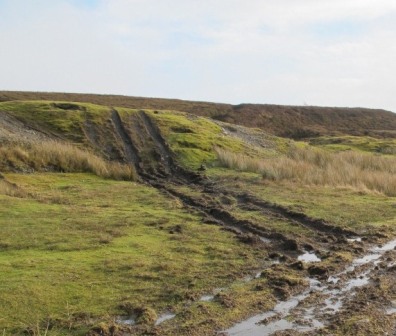
After a recent spate of illegal trespassing by 4x4 vehicles across the Berwyn, Ruabon and Llantysilio mountains Natural Resources Wales is appealing for information from witnesses to prevent further serious damage to key protected areas.
These protected sites are extremely fragile and highly vulnerable to damage caused by a reckless and irresponsible minority, who are determined to pursue their illegal activities regardless of their impacts on wildlife, landscape and the farming community.
Left - the illegal driving of 4x4 vehicles does immense damage to the fragile habitats of Wales. Picture David Smith.
If anyone sees any incidents or would like to report any illegal driving on these sites, please contact North Wales Police on the 101 phone number.
Special moorlands like these are protected by UK and European law and are designated as Sites of Special Scientific Interest (SSSI), Special Areas of Conservation (SAC) and Special Protection Areas (SPAs).
They are protected for important habitats such as blanket bog, holding heather and cotton grass on deep peat and dry heath as well as heather and bilberry on shallow soils.
These areas also provide a home to a whole host of rare birdlife, such as the hen harrier, merlin, peregrine falcon, golden plover, curlew, red grouse and black grouse, many of which are vulnerable to disturbance throughout the year.
The damaged areas also sit within the Clwydian Range Area of Outstanding Natural Beauty (AONB), a UK designation that recognises the importance of the character and natural beauty of the landscape.
The damage being caused to the area poses a real threat to the enjoyment of visitors to the area that provide a boost to the local economy.
As well as providing excellent recreation opportunities and supporting important wildlife these upland sites provide an important service for people.
In good condition, peat can store carbon which prevents it from entering the atmosphere, therefore helping combat climate change.
The land also absorbs large amounts of rainwater which it the gradually releases acting as a natural flood defence in times of heavy rainfall.
These activities also have a direct impact on the livelihood of the local farming community through damage to fences and gates which apart from the financial burden of repairing, allows livestock to wander, making some areas difficult to manage.
North Wales Police Wildlife Crime Officer Sgt Rob Taylor said:
“We are taking these incidents very seriously. It is an offence to cause damage to these important conservation sites. Anyone found to be causing damage to the site is likely face legal proceedings; we would encourage walkers and other in the area to let us know if they see any illegal activity.”
Natural Resources Wales, who have the statutory duty to protect these wildlife sites and manage many of the forest plantations in this area, are working closely with the Police, Denbighshire Countryside Service and landowners to try and prevent this damaging trespass.
David Smith of Natural Resources Wales said:
“These special moorlands are a part of our natural and cultural heritage here in Wales. This activity is completely unacceptable and damages wildlife, farming and the quiet enjoyment of the countryside pursued by the vast majority of visitors. Natural Resources Wales is determined to stop this trespass and we are working to make sure it ceases.”
January 2014 - Morgan Parry
It was with great sadness that we attended the funeral of Morgan Parry on 14th January. With his untimely death at the age of only 56 Wales has been robbed of one of its most committed and able environmentalists.
Below: Morgan Parry

Morgan's passion for the countryside and wildlife of Wales led to him working as a warden for nature reserves in North Wales and to becoming the Director of the North Wales Wildlife Trust. In 2000 he became founder and head of WWF Cymru. Latterly, he was Chair of the Countryside Council for Wales and then a board member of the newly-formed Natural Resources Wales. His personal commitment to reducing Wales's ecological footprint from its present unsustainable level was demonstrated by his important and influential work on the Wales Sustainable Development Scheme, One Wales One Planet. In this endeavour he lead by example, giving up his car; walking his children to school; using public transport to get to his Wales-wide meetings - not an easy undertaking from his base in North Wales.
Morgan believed that the economic development of Wales should be inextricably interwoven with the sustainable use of its natural resources and never at their expense:
"Our relationship with nature has been debated since the emergence of civilisation, from the Greek Philosophers, through the development of the great religions, the enlightenment and the industrial revolution, to the present day. Do we still have an ecological interdependency with the rest of the biosphere, or have we transcended nature and incorporated it into our technoshpere? Does nature have intrinsic value that must be preserved, or is it a resource for us to exploit? Despite our urbanised and computerised lifestyles, our aspirations to transcend our biologoical limitations, we still exist in real rather than virtual landscapes, and we have an inherent recognition of beauty and appreciation of the sublime that we can choose to nuture."
Morgan Parry in A Natural Step? The Countryside Council for Wales 1991 - 2013. Published in April 2013.
Trust Celebrates its Golden Anniversary
Below: Conwy Valley Branch's cake was brought to the top of the Great Orme by a human size badger on the Tram and was cut by Jean Robertson, past Chair of the Branch for 15 years and Hon. Manager of the Trust's Orme shop.
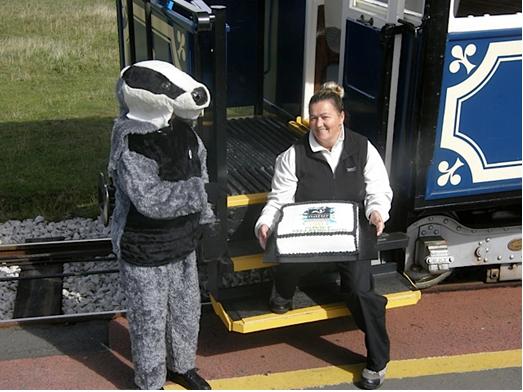
A true 'Golden Moment' was shared across North Wales as each of the six Branches of the North Wales Wildlife Trust marked its 50th Anniversary on Saturday 14th September. Each Branch had a special cake and there was a co-ordinated cutting at precisely 2pm.
Wrexham Branch's cake was cut at a gathering of members and friends in Marford Memorial Hall by Mike Edwards, Councillor for the area, Arfon Branch chose the Spinnies Nature Reserve for their event, with members packed into the hide for the official cutting by Enid Griffiths, long standing member.
Anglesey Branch held their celebration on Cors Goch National Nature Reserve, where the Trust first came into being. Surrounded by a very jolly crowd, the cake was cut by founder members Mattie Davies and Jane Rees.
Meirionnydd Branch's celebration took place on the Mawddach. David Anning (rspb) and Rhys Gwyn (snowdonia national park warden) who support us were there too.
Clwydian Branch members and friends gathered in Dyserth Community Centre for the ceremonial cutting by Clwyd AM, Ann Jones and Roger Pawling.
September 12th 2013 - Work to rejuvenate Newborough Warren dunes to begin
Below: Part of a small area of largely dead or stunted trees will be felled to help wildlife at Newborough. Picture NRW
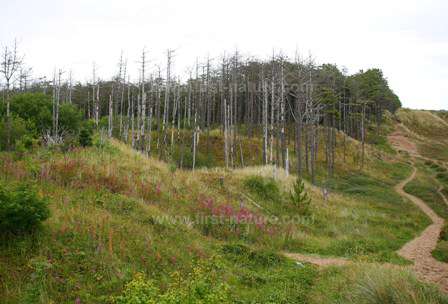
A project to help wildlife behind one of Anglesey’s most popular beaches will begin shortly after the Welsh Government concluded that the scientific basis behind the proposals is sound. Natural Resources Wales will now remove trees from a small part of the forest in Newborough to help rare plants and animals in the area. Work this autumn will clear about six hectares (15 acres) of the 700 hectare (more than 1,700 acres) forest. This is equivalent to about ten football pitches in an area roughly the size of 1,000 football pitches - less than 1 per cent of the total forest area.
Many of the trees to be felled are already dead or stunted and provide little or no benefit to local wildlife – including the forest’s population of red squirrels.
Over recent decades the Corsican Pine plantation, which was mainly planted between the 1940s and mid 1960s, has stabilised the sand dunes. As a result many of the rare plants and animals that live on the dunes have declined.
Removing the trees from this small part of the forest will help some of the dunes near the shore become more mobile again and provide better conditions for wildlife to recover.
The area is so important to wildlife that it’s been designated as both a Site of Special Scientific Interest (SSSI) and a Special Area of Conservation (SAC).
Natural Resources Wales, which has recently invested around £1 million to improve facilities in the area, also emphasises its belief that the site will continue to provide local people with a great area for recreation and benefit the tourist economy in the area.
Tim Jones from Natural Resources Wales said: “This whole area is a great place for people and wildlife, and it’s important for the local economy. We want to make sure that it continues to be so.
“We have made major changes to our earlier plans after lengthy consultations with local people and specialists.
“Helping the landscape take on a more natural appearance will not only help wildlife but it will also enhance the beauty of an area which is hugely valued by local people and the more than 170,000 visitors it attracts each year.
“Local people can continue to enjoy walks in the forest, the local economy can potentially benefit from tourism while wildlife in the forest and dunes is improved.”
Some species have already disappeared from the area including the beetles Anthicus bimaculatus and Asaphidion pallipes which were last seen in the area in 1980 and 1981 respectively, the cranefly Nephrotoma quadristriata, which was last recorded here in 1987, and the snail-killing fly Pherbellia grisescens which hasn’t been seen since 1966.
Other affected include the big ground beetle, Broscus cephalotes, which is now confined to fore-dunes having previously been found throughout the dune system. Some rare plants should also benefit including the Prickly Saltwort Salsola kali, Early Sand-grass Mibora minima, Smooth Cat's-ear Hypochaeris glabra, Blue Fleabane Erigeron acer, Sticky Stork's-bill Erodium lebelii and Dune Fescue Vulpia fasciculata.
The work complies with the European Union’s Habitats Directive. The Forest Plan will also improve the forest itself by measures such as planting more native broadleaf trees.
Sand dune rejuvenation - more...
Newborough Warren NNR - more...
May 31st 2013 - First Fritillary of the year!
The first Marsh Fritillary butterfly of the year has been spotted at Aberbargoed Grasslands on this, the warmest day of spring so far. These iconic creatures require a minimum temperature of 17 degrees C before they take to the wing. Read more...
May 29th 2013 - Good news for the Butterfly Orchids of Cae Blaen Dyffryn
Due to adjustments in the grazing regime at Cae Blaen Dyffryn Plantlife Reserve, near Lampeter, the flowering plants of both Greater Butterfly Orchid -Platanthera chlorantha - and Lesser Butterfly Orchid - Platanthera bifolia - have increased in number from around 50 in 2000 to nearly 10,000 in recent flowering seasons. The best time to see the orchids at Cae Blaen Dyffryn is from mid-June to mid-July, although the cold spring this year may mean that a later visit is better than an earlier one.
May 28th - 2013 - Encouraging news for the sand dune rejuvenation project at Kenfig NNR
Following the commencement of the sand dune rejuvenation project at Kenfig NNR in 2009 some 25 acres of bare sand has been revealed in the hope that the Fen Orchid, which is in steep decline there, will extend its territory. Early indications are promising: a small trial 'scrape' created in 2010 is now home to 10 new plants. Read more...
Opening dates for RSPB Glaslyn Osprey Project for 2013:
Once the Ospreys return, the Glaslyn Osprey Project will be open 5 days per week (closed on Mondays and Fridays) except for Bank Holiday Mondays when it will be open. During the school holidays the project will be open 7 days a week.
6th March 2013 - Official Opening of Gregynog National Nature Reserve
Below: From the left, Karen Armstrong, Director Gregynog, Alastair Hotchkiss, Conservation Officer CCW, Pat O'Reilly MBE, Council Member CCW, Ray Woods, British Lichen Society, Morgan Parry, Chairman CCW, and Dr Liz Siberry, Chair Gregynog Sub-Committee University of Wales, at the opening of Gregynog National Nature Reserve.
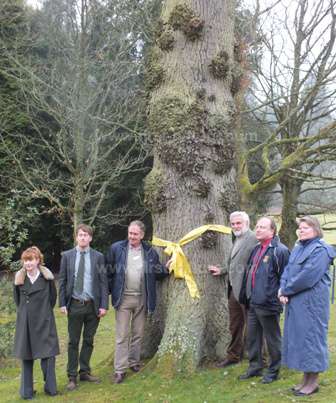
Gregynog National Nature Reserve was officially declared open today in a ceremony held at Gregynog Hall. The event is important for two reasons, firstly because it marks the end of a long history of efforts by conservationists to preserve and protect the special wildlife in Gregynog's parkland, and also because it is the final NNR declaration to be made by the Countryside Council for Wales (CCW) before the establishment of Natural Resources Wales (NRW) on the 1st April 2013.
Of the many fascinating wildlife species to be found in Gregynog's parkland two of the most important are the ancient trees found throughout the park, but particularly in the area known as the Great Wood, and the numerous species of lichen which can only survive on very old trees. Some of the trees in the Great Wood are over 350 years old. More information...
February 2013 - New Fungus Record for Wales
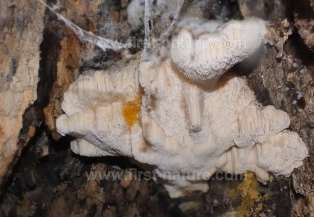
Spotted on a tree at one of Wales's newly designated NNRs, Aberbargoed Grasslands, was Spongy Mazegill - Spongipellis delecans, an extremely rare Red Data List species of fungi. According to records this species has only been found, very occasionally, in a few sites in southern England.
Spongy Mazegill grows on the rotting wood of broad-leaved trees, either on damaged standing trunks, or on large fallen branches. It grows in hoof-shaped brackets which are smooth on top and porous underneath.
January 2013 - New Moss Found in Wales!
Orthotricum cambrense - picture courtesy of Barry Stewart
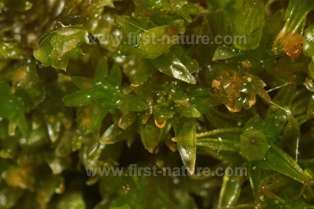
A new moss - Welsh Bristle-moss (Orthotricum cambrense) has been discovered near Dryslwyn Castle in the Tywi Valley, Carmarthenshire. The moss was discovered when a Countryside Council for Wales (CCW) surveyor undertook a survey of mosses on the species-rich Dryslwyn Castle mound. This unfamiliar moss was spotted on some Maple trees in the nearby car park. Welsh Bristle-moss has a unique combination of distinctive traits; it differs from related mosses in its round-tipped leaf tips and flat leaf edges, as well as more subtle features of its spore capsule. CCW moss expert Sam Bosanquet, who made the new find said: “Welsh Bristle-moss highlights the need to be ever vigilant and open-minded, even when looking at plants in mundane places like car parks.
This is a high-point in our regular work of recording mosses which grow on trees in south Wales. Over the last decade, we have also discovered three mosses that had not previously been found in Wales and which are more typical of continental Europe.” There are a few reasons why it is thought that the species wasn’t discovered earlier. The most likely reason is that it has recently evolved from the related Orthotrichum tenellum, which is genetically very similar. Another possibility is that even though no similar species have been discovered elsewhere in Europe it is an undiscovered species that was imported from continental Europe on the young Maples that were used to landscape the car park in the 1990’s. A third possibility is that this new find is restricted to sections of the Tywi floodplain which have never been surveyed before by moss specialists. Sam added: “Now that the species has been recorded, I hope that more research will determine whether the moss is extending its range to other areas of the county and beyond.” The official description of the moss was published jointly by Sam Bosanquet of CCW and Dr Francisco Lara of the Universidad Autónoma de Madrid.
For more information contact CCW Press Officers Brân Devey on 02920 77 2403 / 07747767443 or Helen Evans on 01248 387377 or 07717225589.
October 2012 Cemlyn film – A taste of Cemlyn Nature Reserve!
Following one of the most successful seasons ever at Cemlyn Nature Reserve’s seabird colony on Anglesey, a new short film ‘Cemlyn’,has been produced.
The film gives a flavour of the wildlife at the site, and explores the conservation and education work done by the North Wales Wildlife Trust (NWWT). Greengage Films, who specialise in wildlife and environmental film-making, spent time at the reserve this June, documenting the Cemlyn Bioblitz event and following the daily activities of the two NWWT’s summer wardens.
You can view this evocative film on the NWWT website, or at: http://vimeo.com/48264093
10th September 2012 - Official declaration by CCW of Wales's latest National Nature Reserve - Gregynog National Nature Reserve.
June 29th 2012 - Official opening of the new Visitor Centre and Cafe at the Dol Idris entrance to Cadair Idris NNR. All are welcome to come and see the new interactive exhibition about Cadair Idris NNR and its wildlife, and to enjoy some home-baked treats on offer from the new cafe. More information...
June 14th - Official launch and Declaration of the Aberbargoed Grasslands National Nature Reserve in Caerphilly County Borough. The new NNR is of particular conservation value because of its species rich grasslands and the presence of the rare Marsh Fritillary butterfly.
May 2012 - Cors Dyfi's pair of Ospreys have returned and are rearing two chicks. The newly extended Visitor Centre has new live video feed cameras observing the nest. The nature reserve now benefits from having a kiosk where you can buy food and drinks.
May 2012 - The RSPB Glaslyn Ospreys have returned and are rearing three chicks.
November 2011 - as reported here in March, the Members of the Countryside Council for Wales agreed the proposal to extend the boundary of Clwydian Range Area of Outstanding Natural Beauty to include southern parts of the Clwydian Range, The Vale of Llangollen and the Dee Valley. The decision was forwarded to the Welsh Government for consideration and was confirmed by them on 22nd November.
Summer 2011 - New Orchid Hybrid confirmed in Wales - A rare orchid hybrid has been discovered at Kenfig National Nature Reserve, a site already well known for its orchid populations, and for the presence of the largest number of Fen Orchid (Liparis loeselii) plants to be found in the UK. The new orchid hybrid is a cross between the Southern Marsh-orchid (Dactylorhiza praetermissa) and the Marsh Fragrant-orchid (Gymnadenia densiflora). Three plants were discovered by Michael Clark in 2009, and their identity was confirmed and reported in the Botanical Society of the British Isles's journal in June 2011. The name of the orchid is Dactylodenia ettlingeriana and recognises the work on British Orchids by Derek M Turner Ettlinger.
31st May - new nature reserves and information added to Waleswildlife.com - Glaslyn RSPB Osprey Project, Abercorris North Wales Widlife Trust Nature Reserve, Cors Goch Llanllwch National Nature Reserve, Teifi Marshes Wildlife Trust of South and West Wales Nature Reserve.
31st May 2011 - Cors Dyfi Ospreys. The Osprey that has been arriving at the nest at Cors Dyfi Mongomeryshire Wildlife Trust Nature Reserve since 2008 has found a mate and they have laid three eggs the first of which is due to hatch any day now. More information....
May 2011 - Three mobility scooters have been purchased and are now available at Newport Wetlands NNR which will enable disabled visitors to access parts of the reserve they have not been able to visit before. More information...
May 25th 2011 - a new bird hide has been constructed at Oxwich NNR. It overlooks a wetland just behind the the reserve's main sand dune system, and is the result of of a partnership project between the Countryside Council for Wales and Environment Agency Wales. It was built with the help of volunteers who cleared the site for the bird hide and assisted with the construction of the building. More information about Oxwich NNR...
29th March 2011 - Yesterday (28th March) Members of the Countryside Council for Wales agreed the proposal to extend the boundary of Clwydian Range Area of Outstanding Natural Beauty to include southern parts of the Clwydian Range, The Vale of Llangollen and the Dee Valley. The proposal will now be forwarded to the Welsh Assembly Government for their approval.
28th March 2011 - new nature reserve added to the Waleswildlife.com website is Dyffi NNR. Details...
24th March 2011 - we have just added Cae Blaen Dyffryn to our Nature Reserves section. Details...
North Wales Wildlife Trust Special Events: More information...